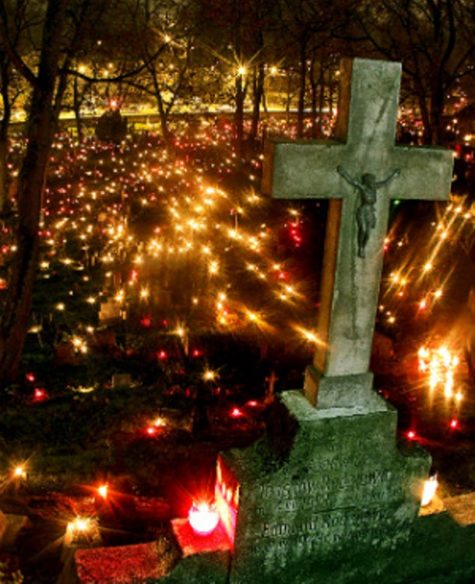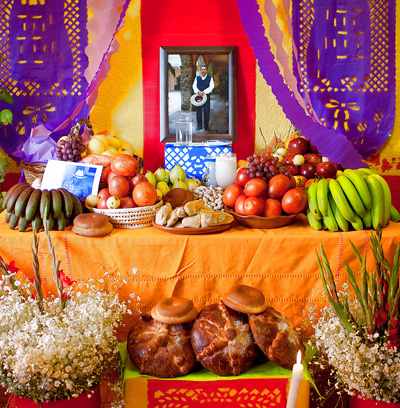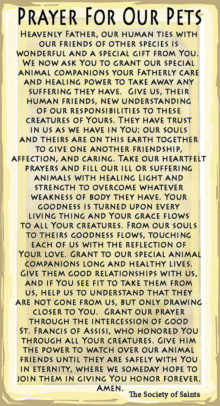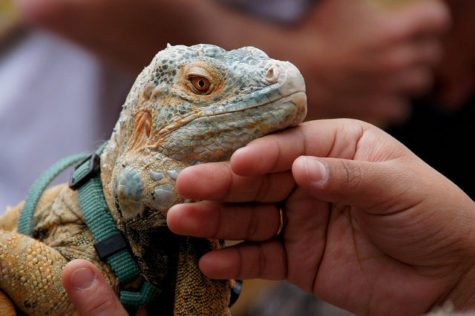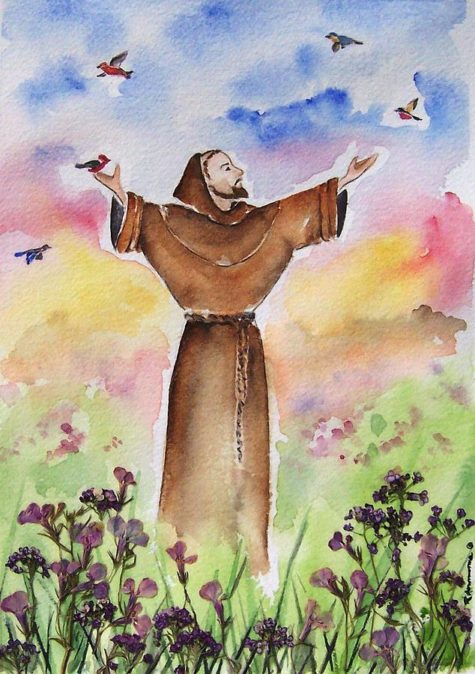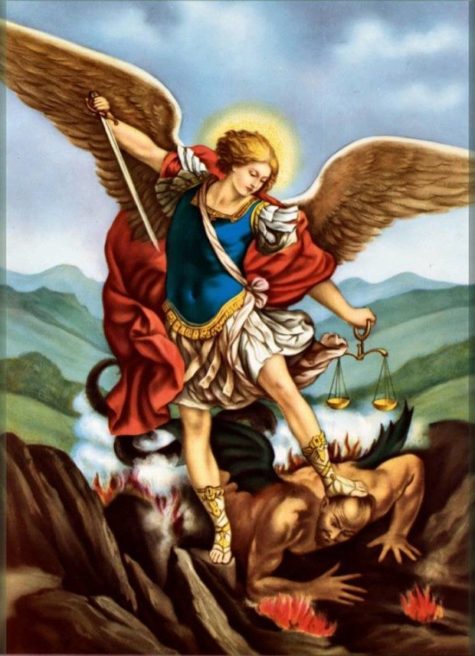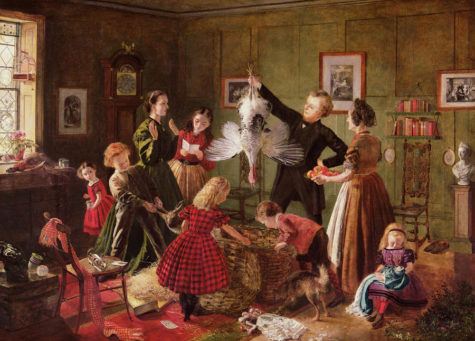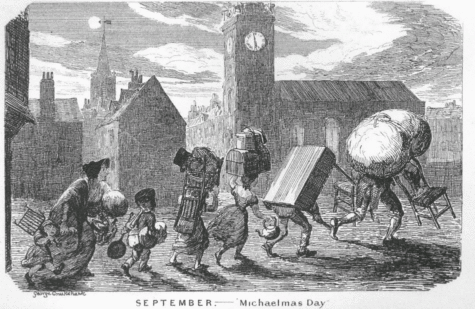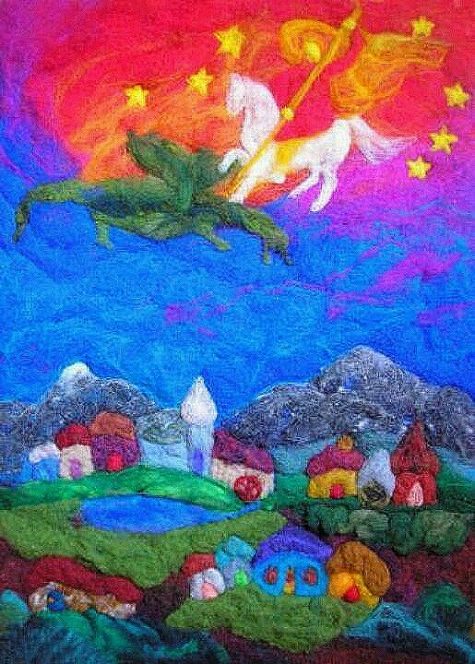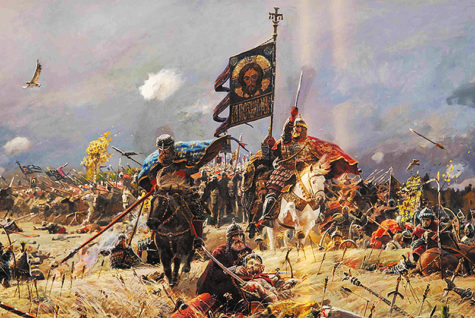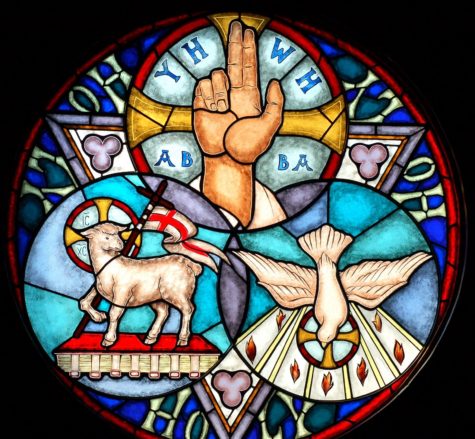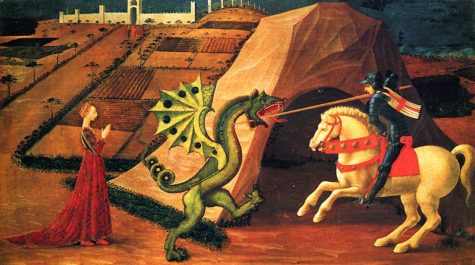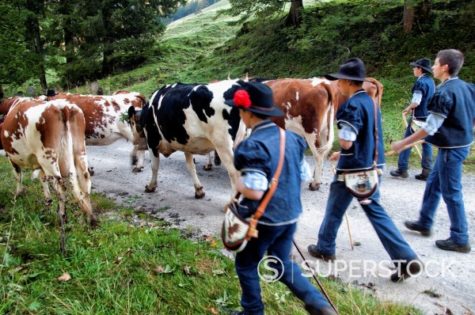Catholic
There is a Mexican saying that we die three deaths: the first when our bodies die, the second when our bodies are lowered into the earth out of sight, and the third when our loved ones forget us.
Some believe that the origins of All Souls’ Day in European folklore and folk belief are related to customs of ancestor veneration practiced worldwide. It is practically universal folk belief that the souls of the dead (or those in Purgatory) are allowed to return to earth on All Souls Day. In Austria, they are said to wander the forests, praying for release. In Poland, they are said to visit their parish churches at midnight, where a light can be seen because of their presence. Afterward, they visit their families, and to make them welcome, a door or window is left open. In many places, a place is set for the dead at supper, or food is otherwise left out for them.
In any case, our beloved dead should be remembered, commemorated, and prayed for.
During our visits to their graves, we spruce up their resting sites, sprinkling them with holy water, leaving votive candles, and adorning them flowers (especially chrysanthemums and marigolds) to symbolize the Eden-like paradise that man was created to enjoy, and may, if saved, enjoy after death and any needed purgation.
Today is a good day to not only remember the dead spiritually, but to tell your children about their ancestors. Bring out those old photo albums and family trees! Write down your family’s stories for your children and grandchildren! Impress upon them the importance of their ancestors!
Traditional foods:
Around the world:
The formal commemoration of the saints and martyrs (All Saints’ Day) existed in the early Christian church since its legalization, and alongside that developed a day for commemoration of all the dead (All Souls’ Day). The modern date of All Souls’ Day was first popularized in the early eleventh century after Abbot Odilo established it as a day for the monks of Cluny and associated monasteries to pray for the souls in purgatory.
Many of these European traditions reflect the dogma of purgatory. For example, ringing bells for the dead was believed to comfort them in their cleansing there, while the sharing of soul cakes with the poor helped to buy the dead a bit of respite from the suffering of purgatory. In the same way, lighting candles was meant to kindle a light for the dead souls languishing in the darkness. Out of this grew the traditions of “going souling” and the baking of special types of bread or cakes.
In Tirol, cakes are left for them on the table and the room kept warm for their comfort. In Brittany, people flock to the cemeteries at nightfall to kneel, bareheaded, at the graves of their loved ones, and to anoint the hollow of the tombstone with holy water or to pour libations of milk on it. At bedtime, the supper is left on the table for the souls.
In Bolivia, many people believe that the dead eat the food that is left out for them. In Brazil people attend a Mass or visit the cemetery taking flowers to decorate their relatives’ grave, but no food is involved.
In Malta many people make pilgrimages to graveyards, not just to visit the graves of their dead relatives, but to experience the special day in all its significance. Visits are not restricted to this day alone. During the month of November, Malta’s cemeteries are frequented by families of the departed. Mass is also said throughout the month, with certain Catholic parishes organizing special events at cemetery chapels.
In Linz, funereal musical pieces known as aequales were played from tower tops on All Soul’s Day and the evening before.
In Mexico “Dia de Los Muertos” (Day of the Dead) is celebrated very joyfully — and colorfully. A special altar, called an ofrenda, is made just for these days of the dead (1 and 2 November). It has at least three tiers, and is covered with pictures of Saints, pictures of and personal items belonging to dead loved ones, skulls, pictures of cavorting skeletons (calaveras), marigolds, water, salt, bread, and a candle for each of their dead (plus one extra so no one is left out).
A special bread is baked just for this day, Pan de Muerto, which is sometimes baked with a toy skeleton inside. The one who finds the skeleton will have “good luck.” This bread is eaten during picnics at the graves along with tamales, cookies, and chocolate. They also make brightly-colored skulls out of sugar to place on the family altars and give to children.
Collected from various sources
Lovely, summer-like days that occur around October 18 are called St. Luke’s Little Summer in honor of the saint’s feast day. In olden days, St. Luke’s Day did not receive as much attention in the secular world as St. John’s Day (June 24) and Michaelmas (September 29), so to keep from being forgotten, St. Luke presented us with some golden days to cherish before the coming of winter, or so the story goes. Some folks call this Indian Summer, but that officially occurs between November 11 and November 2
Traditional Catholic Celebrations:
Saint Luke’s Feast Day can be celebrated by reading the Acts of Apostles and praying the three canticles he preserved for us – the Benedictus, the Magnificat and the Nunc Dimittis. As the first Christian physician, Saint Luke is the patron saint of physicians and surgeons. For this reason, we honor Saint Luke on his feast day by praying through his intercession for doctors and those who care for the sick.
Found at: Almanac.com
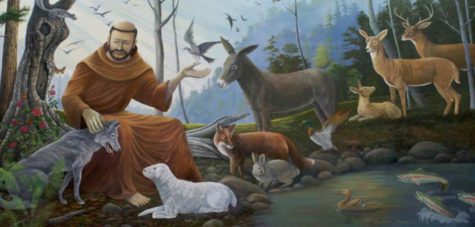
The blessing of pets and animals is a Catholic holy day often celebrated on October 4, the feast of St. Francis of Assisi, or on a Sunday near that date.
In the Scriptures, the act of blessing means ‘the imparting of power or life.’ The person performing the blessing is mediating that power from God or Christ to the person performing or the animal involved. To bless is more than an expression of goodwill and caring. To bless is to impart God’s power in person! The blessing of each animal, by name, means that health, healing and life are being mediated from God for the benefit of the animal in its relationship with its human partners. Be careful not to reinforce the separation of human animals and other animals by this blessing. Instead, consider reinforcing our common kinship by blessing ALL animals–human and otherwise.
A Prayer For Our Pets
Heavenly Father, our human ties with our friends of other species is wonderful and a special gift from you. We now ask you to grant our special animal companions your fatherly care and healing power to take away any suffering they have.
Give us, their human friends, new understanding of our responsibilities to these creatures of yours. They have trust in us as we have in you; our souls and theirs are on this earth together to give one another friendship, affection, and caring.
Take our heartfelt prayers and fill our ill or suffering animals with healing light and strength to overcome whatever weakness of body they have.
Your goodness is turned upon every living thing and your grace flows to all your creatures.
From our souls to theirs goodness flows, touching each of us with the reflection of your love.
Grant to our special animal companions long and healthy lives. Give them good relationships with us, and if you see fit to take them from us, help us to understand that they are not gone from us, but only drawing closer to you.
Grant our prayer through the intercession of Good St. Francis of Assisi, who honored you through all your creatures. Give him the power to watch over our animal friends until they are safely with you in eternity, where we someday hope to join them in giving you honor forever.
Amen
Blessing of All the Animals: A Sermon
Here’s a transcript of a catholic sermon by David Rhoads, often used as part of the services for the Blessing of the Animals. I thought it might be interesting to use it as a sort of template for any blessings that I might want to do today. While I am not a catholic, or even a follower of any christian religion, I did think it had possibilities as a jumping off point, and with some creative changes, it might be quite pagan and wonderful.
So, here it is, I’d love to see what you can do with it:
And God said, “Let the waters bring forth swarms of living creatures, and let birds fly above the earth across the dome of the sky.” So God created the great sea monsters and every living creature that moves, of every kind, with which the waters swarm and every winged bird of every kind. And God saw that it was good. And God blessed them, saying, “Be fruitful and multiply and fill the waters in the sea, and let birds multiply on the earth. . . . And God said, “Let the earth bring forth creatures of every kind: cattle and creeping things and wild animals of the earth of every kind.” And it was so. God made the wild animals of the earth of every kind, and the cattle of every kind and everything that creeps upon the ground of every kind. And God saw that it was good
~Genesis 1: 20-25
First, I want to address you varieties of dogs and cats and other creatures who are here today. And I want to speak with you fish and ferrets and hamsters and parakeets and snakes brought here today by your human companions. You are here for your own sake, and you also represent all those who are not here today, animals of every kind—cattle and goats and horses and elephants and bees and cougars and crocodiles and puffer fish and eels and insects—so many we cannot name them all.
I want to announce the good news to all you creatures. I want you to know that God loves you. God loves you for your own sake—and not because of what you can do for humans.
You are good in yourselves. The good book tells us that when God created you—fish of the sea and birds of the air and creatures of the land—God looked at all God had created, and God saw that “indeed, it was very good!”
When God created you, God blessed you. God told you to “Be fruitful and multiply and fill the earth.”
God created you in huge swarms and in great diversity. God wants all of you to survive and to thrive on Earth.God created the world for you, so that you have what you need to live.
The psalmist tells us that God made the rain to water the trees, the trees for you birds to nest, the grass for you cattle to graze, and the crags as a refuge for you mountain goats. God wants you to receive your “food in due season” and to be “filled with good things.”
The Bible tells us that when the flood came, God rescued each of your species through Noah in the ark. And God made a covenant with you fish of the sea and birds of the air and domestic animals and all animals on Earth to protect you for the future. God made the first “endangered species act.”
Just like us, you are called to worship God. The hills are to clap their hands. The fields are to exalt. You cattle and dogs and cats are to praise God by being who you are and exalting in it. John the seer had a vision in which he heard the entire creation—everything in heaven, on the earth, under the earth and in the sea—cry out in praise: “Blessing and honor and glory and power be to our God and to the lamb forever and ever.”
We human animals need to confess to you that we have systematically mistreated you, depleted your numbers, destroyed you, slaughtered you, crowded you out, neglected you, dealt with you as commodities in our quest for comfort and ease. We have not seen you as God’s creatures. We have not shown proper reverence or respect. Against God’s will, we have not set limits upon ourselves so that you might live and thrive. What we have done! We are sorry!
You who are here today are so fortunate because you have human companions who care for you. But so many of your cousins are threatened with extinction—snow leopards and timber wolves and green sea turtles and condors and paddlefish and fin whales among so many others. We humans may so crowd out or deplete these kin of yours that not a single one of them will ever again exist on Earth.
When we destroy you and diminish you in these ways, we not only compromise your ability to survive, we also stifle your capacity to praise God. Along with all creation, you are groaning in labor pains, waiting for the revelation of children of God who will care for creation and make provisions for you to thrive.
Now I want to address you human creatures. I want to announce the good news to you also. God loves you. God loves you for your own sake and wants you to thrive. When God made you; God saw that this too was good.
God said also to you: “Be fruitful and multiply and fill the Earth”. Yet we have already done this! So we need to find ways to limit the impact of our species, because God did not mean for us to crowd out the rights of other creatures to be fruitful and multiply also. In developed countries, we have become like an infestation—taking over land and destroying habitats and devouring species and infiltrating homes and migratory routes of so many other animals—and we need to learn our limits and exercise restraint.
God even created us humans with a special responsibility—to exercise dominion. This does not mean that we are to exercise domination over other creatures or to exploit them for human mis-use. Rather, we are to delight in other creatures, as God does, and respect and care for them. Our love for creation is the only basis for our right use of creation. We are to exercise dominion as servants of creation. As Jesus has said, we are not to lord over anyone, but be as slaves to all. We are to take responsibility for all creatures, to serve their needs, and to work to preserve them.
And we are to do this not with a sense of superiority but in solidarity with all other creatures. We were created to be together, to be companions to one another, to thrive all together. All animals are our cousins, our kin. And God made a covenant with us and with all other animals together. Admit it, we humans are also animals, primate mammals.
And Jesus was a mammal. Jesus was born and lived in solidarity with all of life. Jesus lived to care about all who were oppressed and made vulnerable and marginalized by society; and right now that includes most creatures, not just humans. Jesus died in order that God might reconcile to God’s self all things in creation.
In response to God’s love, we are freed to behave in ways that enable all of life to thrive together. You do not need to prove anything. You can set limits on yourselves. You can simplify your lifestyle so that others may survive and thrive. You can become aware the effects of your actions on other creatures and curtail your activity. You can act to establish and restore safe homes and habitats for those animals that are endangered.
Now I want to address all of you creatures together. I had this vision in a dream during sleep at night. I was in the front row of a cathedral looking at the scene before me during a service of communion. I saw the priest passing bread to the first person kneeling at the communion railing. As I looked, the next figure at the railing was a snake! It was curled at the bottom with its back arching up over the rail and with head straining forward to receive the grace of Christ. The next figure was another person. Next was a raccoon with paws up on the communion rail leaning forward to receive the grace of Christ. Then I saw a bird perched on the corner of the railing eating bread crumbs.
As I finished surveying this scene in my dream, suddenly the side walls of the cathedral fell away and outside was thick foliage of forest and jungle on each side with all manner of wild animals roaming around. In this moment, it seemed as if walls of separation had been removed and there was a seamless web of all creation praising God and exalting in the grace of Christ.
From the time I awoke from that dream until this day, I have never been able to think of worship in the same way again. I now see all of Earth as the sanctuary in which we worship, and I see myself invoking and confessing and giving thanks and praising God and offering myself in solidarity with all of life. May that vision also be your vision.
You who are here today are very fortunate because you and have a relationship of love and care and loyalty between yourself and your human or your pet companion. You model how all relationships between humans and other animals should be. We wish to project this relationship as the model for our human relationship with all animals. May we care about all animals as we care for our companions at home.
I invite you all to come forward for a blessing. Sometimes when we have a service for the Blessing of the Animals, we bless only the non-human animals, as if we ourselves are not also animals. Therefore, as an expression of solidarity with each other, I invite all of you—non-human animals and human animals alike—to come for a blessing together. We bless you as companions together and we bless your relationship:
“May God bless each of you with health and safety and well-being and long life. And may God bless your relationship together so that it may be filled with love and joy.”
Many churches celebrate the Feast of St Francis of Assisi on October 4 each year. The feast commemorates the life of St Francis, who was born in the 12th century and is the Catholic Church’s patron saint of animals and the environment. It is a popular day for pets to be “blessed”.
About St Francis
St. Francis of Assisi (1182-1226) was the founder of the Franciscan Order. The son of a wealthy merchant named Pietro di Bernardone, he publicly denounced his father’s wealth in 1206 and dedicated his life to prayer and serving the poor. Pope Innocent III eventually gave Francis and his followers permission to preach, and he ordained Francis a deacon. The followers of Francis were called Friars Minor, or “the lesser brethren.” Francis died on October 3, 1226, and was canonized in 1228.
Text from his Sermon to the Birds:
“My little sisters, the birds, much bounden are ye unto God, your Creator, and always in every place ought ye to praise Him, for that He hath given you liberty to fly about everywhere, and hath also given you double and triple rainment; moreover He preserved your seed in the ark of Noah, that your race might not perish out of the world; still more are ye beholden to Him for the element of the air which He hath appointed for you; beyond all this, ye sow not, neither do you reap; and God feedeth you, and giveth you the streams and fountains for your drink; the mountains and valleys for your refuge and the high trees whereon to make your nests; and because ye know not how to spin or sow, God clotheth you, you and your children; wherefore your Creator loveth you much, seeing that He hath bestowed on you so many benefits; and therefore, my little sisters, beware of the sin of ingratitude, and study always to give praises unto God.”
-Saint Francis of Assisi (c.1220)
From: Almanac.com Continue reading
In the Roman Catholic Church calendar, October 2 is the day for honoring guardian angels.
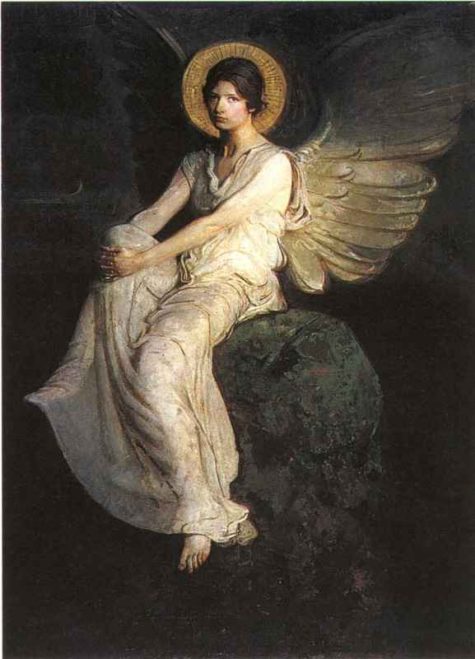
As with other mystical concepts, many legends surround guardian angels. Some people believe we have only one guardian angel at our side throughout this lifetime to help us make important decisions and protect us. Others believe each human has thousands of guardian angels.
Still others hold the belief that, although we have one angel assigned to us, others come to our aid when we are in deep trouble or when we begin various projects where their help can be of assistance. As one progresses spiritually, various angels may visit us at intervals, helping us along and teaching us what we need to know.
Finally some individuals believe that angels are our higher selves – the part of us that is spiritual in nature and attuned to the universe.
Whatever your beliefs, it is always beneficial to take time out to honor and give gratitude to the angelic spirits that guide and protect you.
September 29th is a medieval holiday which the Church Christianized under the label of “Michaelmas,” a feast in honor of the Archangel Michael. It is thought that the Roman Catholic Church at some point considered assigning the quarter dates to the four Archangels, since they had assigned the cross quarters to the four gospel-writers.
The feast day of St. Michael, the archangel and overcomer of the Devil, is a Christian celebration. Its main importance in people’s lives was that of a seasonal signpost in the year. In the British Isles, crops were harvested and the surplus sold by late September, so this became the time when farmers would pay their yearly rents to landowners.
Everyone ate goose at Michaelmas to bring prosperity, and many farmers included “a goose fit for the lord’s dinner” with their rent payments. Great market fairs occurred just before the feast day, and the large crowds these attracted made it convenient to hold elections at this time. Michaelmas is also a “Quarter Day.”
The ancient Celtic people divided the year into four major sections, or quarters, and then divided each of these in half to make an eight-part year that reflected the natural progression of the seasons. Foods traditional for Michaelmas include new wine; goose; cakes of oats, barley, and rye; and carrots. Some groups in the United States, such as the Pennsylvania Dutch, have kept Michaelmas, or “Harvest Home,” traditions alive.
During the Middle Ages, Michaelmas was celebrated as a Holy Day of Obligation, but this tradition was abolished in the 18th century. Lutheran Christians consider it a principal feast of Christ.
It was also one of the Welsh and Irish quarter days when accounts had to be settled. On manors, it was the day when a reeve was elected from the peasants. Traditional meal for the day includes goose (a “stubble-goose”, i.e. one prepared around harvest time) and a special cake called a St Michael’s bannock.
A Note About Dates:
There is evidence that Michaelmas was once celebrated later in the year, on the 10th or 11th of October, this is now referred to as ‘Old Michaelmas Day’. There may also have been a time when both dates for Michaelmas were acknowledged.
I like the legend of teenage girls collecting crab apples at the beginning of September, and arranging them in the initials of boys they fancied. If they could still discern the initials on Old Michaelmas Day, then then true love and romance would follow. The legend conjures two unrelated thoughts in my mind, firstly, would other girls mischievously re-arrange the apples to form the initials of a different boy. Secondly, what is the modern equivalent of this courtship ritual?
It’s interesting that certain customs transfer from one season to another. For example, two people snapping the the Michaelmas goose’s wishbone and thinking of a secret desire. Also, the concept of a Michaelmas Pie with ring, according to this legend, the lucky recipient will be engaged by Christmas and marry by Easter. Variations on these themes occur at Christmas and possibly at Thanksgiving.
Michaelmas Customs and Lore
According to an old legend, blackberries should not be picked after this date.
This is because, so folklore goes, Satan was banished from Heaven on this day, fell into a blackberry bush and cursed the brambles as he fell into them. In Yorkshire, it is said that the devil had spat on them. This old legend is well known in all parts of the United Kingdom, even as far north as the Orkney Islands. In Cornwall, a similar legend prevails, however, the saying goes that the devil urinated on them.
This is one Michaelmas custom that survives to this day, although sometimes it is said that you should not eat blackberries after the 29th of September. There is a very good reason for this custom, namely that by this time of year blackberries are tasteless and watery.
Other fruits, particularly nuts and rose-hips also have customs associated with Michaelmas. For example, ‘Hipping Day’ in Yorkshire, or Michaelmas pie in Ireland (Made of apples).
- Mop Fairs (Hiring Time):
Michaelmas was traditionally time when laborers and servants were hired. As the name suggests, maids would carry mops, but other trades carried the tools of their trades.
Thus the squires or the lord’s of the manor could tell what skills the prospective employees had, for example, a Shepherds his crook, and a gardener a rake.
- Fishing:
Michaelmas marks the end of the fishing season.
- Curfew:
The start of the curfew for winter night nights. The local church bell sounded each night from Michaelmas until lent. Curfew is derived from the French phrase ‘courve feu’, which means to cover, or to dowse a fire.
- Rent:
When tenants came to pay their quarter’s rent, they bring a fowl at Midsummer, a dish of fish in Lent, a capon at Christmas, and on Michaelmas Day, a goose.
- Trees:
This is traditionally a good time to plant trees as evidenced by this old saying, “A Tree planted at Michaelmas, will surely not go amiss.”
More Michaelmas Lore:
At Michaelmas time, or a little before,
Half an apple goes to the core;
At Christmas time, or a little after,
A crab in the hedge, and thanks to the rafter.
- If you eat goose on Michaelmas Day, you will not be short of money all year round.
- A Michaelmas rot comes ne’er in the pot.
- If St Michael brings many acorns, Christmas will cover the fields with snow.
- Michaelmas chickens and parsons’ daughters never come to good.
- Three things that never come to any good: Christmas pigs, Michaelmas fowls, and parsons’ daughters.
- So many days the moon is old on St Michael’s day, so many floods after.
- Harvest comes as long before Michaelmas as dog roses bloom before Midsummer.
- On Michaelmas Day the devil puts his foot on the blackberries.
- St Michael’s rain does not stay long in the sky.
- If it does not rain on St Michael’s and Gallus [Oct 16], a dry spring is indicated for the next year.
Collected from a variety of sources
Vidovdan (St. Vitus Day) is one of the important religious holidays for the Serbs. It’s annually observed on 28 June (Gregorian Calendar), or 15 June according to the Julian calendar, in use by the Serbian Orthodox Church to venerate St. Vitus. It is an important part of Serb ethnic and Serbian national identity.
Observation of this feast is connected with the Battle of Kosovo in 1389. According to the Serbian Orthodox tradition, the Serbian national identity was founded on the day, when the Ottoman Empire defeated Serbia in the Battle of Kosovo and slew prince Lazar. Ruling sultan of the Ottoman Empire was killed on the same day by Serbian knight Miloš Obilić.
Serbs consider Vidovdan a very important day, that is why many historic events in Serbia took place on June 28, for instance, signing of the Treaty of Versailles (1919), proclamation of Serbian constitution (1921), Slobodan Milošević’s deportation to the International Criminal Tribunal, etc.
In the late Middle Ages, people in Germany and countries such as Latvia celebrated the feast of Vitus by dancing before his statue. This dancing became popular and the name “Saint Vitus Dance” was given to the neurological disorder Sydenham’s chorea. It also led to Vitus being considered the patron saint of dancers and of entertainers in general.
It is also a day for weather watching:
“If St. Vitus’ Day be rainy weather,
It will rain for 30 days together.”
About St Vitus:
There are no reliable facts about existence of Saint Vitus. According to Christian legend, Vitus was the son of Roman senator from Sicily. He converted to Christianity under influence of his mentor. Satin Vitus died as a martyr during the persecution of Christians by Roman Emperors Diocletian and Maximian.
Vitus is considered the patron saint of actors, comedians, dancers, and epileptics, similarly to Genesius of Rome. He is also said to protect against lightning strikes, animal attacks and oversleeping.
Sources: Wikipedia and Any Day Guide
The Fête de la Saint-Jean-Baptiste, held annually on June 24, is the feast day of St John the Baptist, a Jewish preacher who according to the Christian tradition, baptized Jesus in the River Jordan. It is a day of celebration in Quebec and other areas of French Canada. The feast day of Saint John the Baptist or Midsummer was a very popular event in the Ancien Régime of France, and it is still celebrated as a religious feast day in several countries, like Denmark, Norway, Sweden, Finland, Estonia, Spain, Latvia and Lithuania.
Other names for this holiday include the following:
- Saint Jean Baptiste Day
- La Saint-Jean
- St John the Baptist Day
- Fête nationale du Québec
- Quebec’s National Holiday
This is a historical, cultural, national and religious holiday. It is observed by Quebecers, French Canadians, French Americans. Celebrations include parades, bonfires, fireworks, feasting, drinking, musical concerts, flag waving, patriotic speeches, and contests.
Symbols
The flag of Quebec and the fleurs-de-lis are widespread symbols of Saint Jean Baptiste Day. Many people choose to wear blue or white clothing to the celebrations. The fleurs-de-lis represents the flower of an iris or a lily. The fleurs-de-lis is also associated with the Virgin Mary and her purity. It was a symbol of French speaking people and their kings after King Clovis I converted to Christianity in the year 493. It was taken from the papal seal or coat-of-arms when the king converted, to symbolize the strength and significance of the French nation in its union with the Papal state. Quebec’s flag is one-and-a half times as wide as it is high and has a blue background. The background is divided into four rectangles by a cross and each of the four rectangles contains a single white fleurs-de-lis.
What Do People Do?
Various events are organized on Saint Jean Baptiste Day. These range from large scale public celebrations, such as rock and jazz concerts, sports tournaments, parades and firework displays, to small family or neighborhood happenings, such as yard sales, picnics, barbecues, bonfires and children’s entertainment. Many church bells ring in celebration and public dances and fun fairs are held. Some events may be held on the evening of June 23 and many are broadcast live on television, radio or on the Internet. The celebrations are coordinated by the Mouvement national des Québécoises et des Québécois.
Public Life
Saint Jean Baptiste Day is a public holiday in the Canadian province of Quebec. Post offices and many stores are closed. Public transport services run to a reduced schedule in some places or may not run at all in other areas, such as the province’s rural regions. If June 24 falls on a Sunday, the same day is a paid day off for those who work on Sunday. June 25 becomes a paid day off for workers who do not ordinarily work on Sunday.
Background
In ancient times, the summer solstice was honored around June 21. Midsummer festivals, such as those linked with the June solstice, were held in Europe for thousands of years. In the fifth century, Christianity spread through France. When people converted to Christianity, elements of these festivals were combined with feast days for Christian saints. June 24 – the feast day of St John was substituted for the pagan Midsummer celebrations. Traditionally, bonfires would be lit on the eve of June 24 in order to honor the saint.
In France, the celebrations around the feast day of Saint John the Baptist were widely enjoyed and French colonists introduced these traditions to North America.
The patriotic tone of the Saint Jean Baptiste Day celebrations began in 1834. In that year Ludger Duvernay, an influential journalist, visited the St Patrick’s Day celebrations in Montreal, and was inspired to create a similar event for French Canadians. In 1843, he established the Saint Jean Baptiste Society to promote the celebration of Saint Jean Baptiste Day. This organization was supported by the Catholic Church, which saw it as a way to promote social and moral progress. In 1908 St John the Baptist was designated as the patron Saint of Quebec, re-enforcing the connection between Saint Jean Baptiste Day and French-Canadian patriotism.
The celebrations were supported by the Catholic Church and were primarily religious around that time. The lighting of bonfires, a traditional custom on the Nativity of Saint John which ultimately reached back to pre-Christian Midsummer celebrations were still lit at night. In addition, the first Saint-Jean-Baptiste parades were organized. They became an important tradition over time. The procession of allegorical floats was introduced in 1874.
During and after World War I, Saint Jean Baptiste Day was barely celebrated, but in 1925 Saint Jean Baptiste Day became a provincial holiday in Quebec. After a period in the 1960s, when the structure of society in Quebec changed greatly, this holiday became very political. During the Quiet Revolution, the event took a political turn, with many riots and protests taking place.
However, in 1977 Saint Jean Baptiste Day was recognized as the ‘national’ holiday of Quebec and the mood of the celebrations gradually moved towards that of the secular celebrations in modern times.
By making it a statutory holiday, the day became a holiday for all Quebecers rather than only those of French-Canadian or Catholic origins. Celebrations were gradually secularized. While the religious significance of the civic celebration is gone, the day remains popularly called la St-Jean-Baptiste or simply la St-Jean and is still observed in churches.
Collected from various sources
Trinity Sunday is celebrated in all the Western liturgical churches: Roman Catholic, Anglican, Lutheran, Presbyterian, United Church of Christ, and Methodist.
Trinity Sunday is the first Sunday after Pentecost and is celebrated by many Christians in the United States. It is one of the few feasts that are celebrated as a doctrine of the church rather than an event in its sacred history. It is also symbolic of the unity of the Trinity.
On Trinity Sunday many Christians around the world remember and honor the belief of an eternal God, consisting of the Father, Son and Holy Spirit. Many churches have special prayers on Trinity Sunday. The Athanasian Creed, named after St Athanasius, Archbishop of Alexandria, is recited in some churches on Trinity Sunday because of its strong affirmation of the Triune nature of God.
In pre-revolutionary Russia, Trinity Sunday was a grand celebration. Churches and homes were decorated with wreaths, fresh flowers and grass and saplings. It was a time of weddings, and young unwed women would sometimes toss fresh wreaths during the next year. If a wreath floated the woman was destine to marry. If it sank, she would remain unwed. With the coming of communism came the belief that holidays were a way of exploiting the masses and preventing productivity. This particular holiday was turned into an arbor day.
In traditional Methodist usage, The Book of Worship for Church and Home (1965) provides the following Collects for Trinity Sunday:
Almighty and everlasting God, who hast given unto us thy servants grace, by the confession of a true faith, to acknowledge the glory of the eternal Trinity, and in the power of the divine majesty to worship the unity: We beseech thee to keep us steadfast in this faith and evermore defend us from all adversities who livest and reignest, one God, world without end. Amen.
Almighty and everlasting God, who hast revealed thyself as Father, Son, and Holy Spirit, ,and dost ever live and reign in the perfect unity of love: Grant that we may always hold firmly and joyfully to this faith, and, living in praise of thy divine majesty, may finally be one in thee; who art three persons in one God, world without end. Amen.
Johann Sebastian Bach composed a number of cantatas for Trinity Sunday. Including:
- O holy bath of Spirit and water – O heilges Geist- und Wasserbad, BWV 165
- There is something defiant and fainthearted – Es ist ein trotzig und verzagt Ding, BWV 176
- Most highly desired festival of joy – Gelobet sei der Herr, mein Gott, BWV 129.
Collected from various sources
Saint George’s Day is celebrated on April 23, the traditionally accepted date of the saint’s death in AD 303. For those Eastern Orthodox Churches which use the Julian calendar, this date currently falls on the day of 6 May of the Gregorian calendar. In Turkish culture the day is known as Hıdırellez or Xıdır Nəbi and is symbolic of spring renewal.
It is also believed to be a magical day when all evil spells can be broken. It was believed that the saint helps the crops to grow and blesses the morning dew, so early in the morning they walked in the pastures and meadows and collected dew, washed their face, hands and feet in it for good luck and even in some rural parts of Bulgaria it was a custom to roll in it naked.
In Romania, people celebrate St. George – ‘Sfantul Gheorghe’ – and in certain regions, including Bucovina, people will still plant cut willow branches in freshly cut earth and place them at the entrances to their homes.
Many Christian denominations in Syria celebrate St George’s Day, especially in the Homs Governorate. They do this by dressing small children as dragons and chasing them through the streets whilst beating them with clubs and batons. It is a very special time of year, after the beatings folks will enjoy a sit down dinner and dancing.
Saint George’s Day is the feast day of Saint George as celebrated by various Christian Churches and by the several nations, kingdoms, countries, and cities of which Saint George is the patron saint.
Since Easter often falls close to Saint George’s Day, the church celebration of the feast may be moved to accommodate the Easter Festivities. Similarly, the Eastern Orthodox celebration of the feast moves accordingly to the first Monday after Easter or, as it is sometimes called, to the Monday of Bright Week.
Some Orthodox Churches have additional feasts dedicated to St George. The country of Georgia celebrates the feast of St. George on April 23, and, more prominently, November 10 (Julian calendar), which currently fall on May 6 and November 23 (Gregorian calendar), respectively.
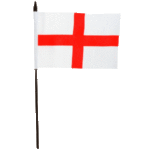 St George’s Day was a major feast and national holiday in England on a par with Christmas from the early 15th century. The Cross of St. George was flown in 1497 by John Cabot on his voyage to discover Newfoundland and later by Sir Francis Drake and Sir Walter Raleigh. In 1620 it was the flag that was flown on the foremast of the Mayflower when the Pilgrim Fathers arrived in Plymouth, Massachusetts.
St George’s Day was a major feast and national holiday in England on a par with Christmas from the early 15th century. The Cross of St. George was flown in 1497 by John Cabot on his voyage to discover Newfoundland and later by Sir Francis Drake and Sir Walter Raleigh. In 1620 it was the flag that was flown on the foremast of the Mayflower when the Pilgrim Fathers arrived in Plymouth, Massachusetts.
The tradition of celebration St George’s day had waned by the end of the 18th century after the union of England and Scotland. Nevertheless, the link with St. George continues today, for example Salisbury holds an annual St. George’s Day pageant, the origins of which are believed to go back to the 13th century. In recent years the popularity of St. George’s Day appears to be increasing gradually. Today, St. George’s day may be celebrated with anything English including morris dancing and Punch and Judy shows.
A traditional custom on St George’s day is to wear a red rose in one’s lapel, though this is no longer widely practiced. Another custom is to fly or adorn the St George’s Cross flag in some way: pubs in particular can be seen on April 23 festooned with garlands of St George’s crosses. It is customary for the hymn “Jerusalem” to be sung in cathedrals, churches and chapels on St George’s Day, or on the Sunday closest to it. Traditional English food and drink may be consumed.
In the Valencian city of Alcoi, Saint George’s Day is commemorated as a thanksgiving celebration for the proclaimed aid the Saint provided to the Christian troops fighting the Muslims in the siege of the city. Its citizens commemorate the day with a festivity in which thousands of people parade in medieval costumes, forming two “armies” of Moors and Christians and re-enacting the siege that gave the city to the Christians.
The Serbian St George’s Day is called Đurđevdan and is celebrated on 6 May every year, as the Serbian Orthodox Church uses the Julian, Old Style calendar. Đurđevdan is also celebrated by both Orthodox and Muslim Romani and Muslim Gorani. Đurđevdan is celebrated, especially, in the areas of Raška in Serbia, and is marked by morning picnics, music, and folk dances.
In Russia, St George’s Day (Гергьовден, Gergyovden) is a public holiday that takes place on 6 May each year. It is possibly the most celebrated name day in the country. A common ritual is to prepare and eat a whole lamb, which is an ancient practice possibly related to Slavic pagan sacrificial traditions and the fact that St George is the patron saint of shepherds.
A Protective Blessing Ritual for Saint George’s Day:
In many communities, Saint George’s Day was the day animals were lead out into the field, thus protective, blessing rituals abound. Here’s one:
- Lead all healthy animals three times around the perimeter of their field, barn or home, always in a sunwise direction.
- The person leading the parade carries a lit torch.
- The person bringing up the rear holds an open padlock in one hand, the key in the other hand.
- After the third round, the animals are lead back into the barn.
- Turn the key in the lock.
- Throw the key into a river or stream, while preserving the now permanently locked padlock.
Dragons and Dragon’s Blood:
St. George is credited with having slain a fearsome dragon to save the life of a virgin. The Dragon means different things to different peoples. In some medieval traditions it is linked with the devil or Satan, hence the carvings and windows depicting St George, (or sometimes St Michael), slaying one.
But the Dragon has far older associations in which it represents the life force of the land. In the Craft we often refer to the Earth Dragon, a great coiled beast who sleeps within the Earth and who can be called upon to work healing for the planet. The Earth Dragon is often invoked in cases of potential ecological danger. King Arthur’s father was named Uther Pendragon, and it is thought that his name shows that he was a defender of the land. The Dragon is a symbol of Wales and appears on the country’s flag.
Dragon’s blood is not the blood of some luckless lizard, but the resin of the palm calimus draco. Magically it is used for spells of protection, exorcism and sexual potency. Added to incenses it increases their potency and drives away all negativity. On its own Dragon’s blood can be burnt at an open window to secure a lover’s return, and a piece of the resin placed under the mattress is said to cure impotence. In the past Dragon’s Blood was used medicinally to cure diarrhoea, dysentery and even syphilis. Like many other resins it is also used to stop bleeding wounds.
Sources:
